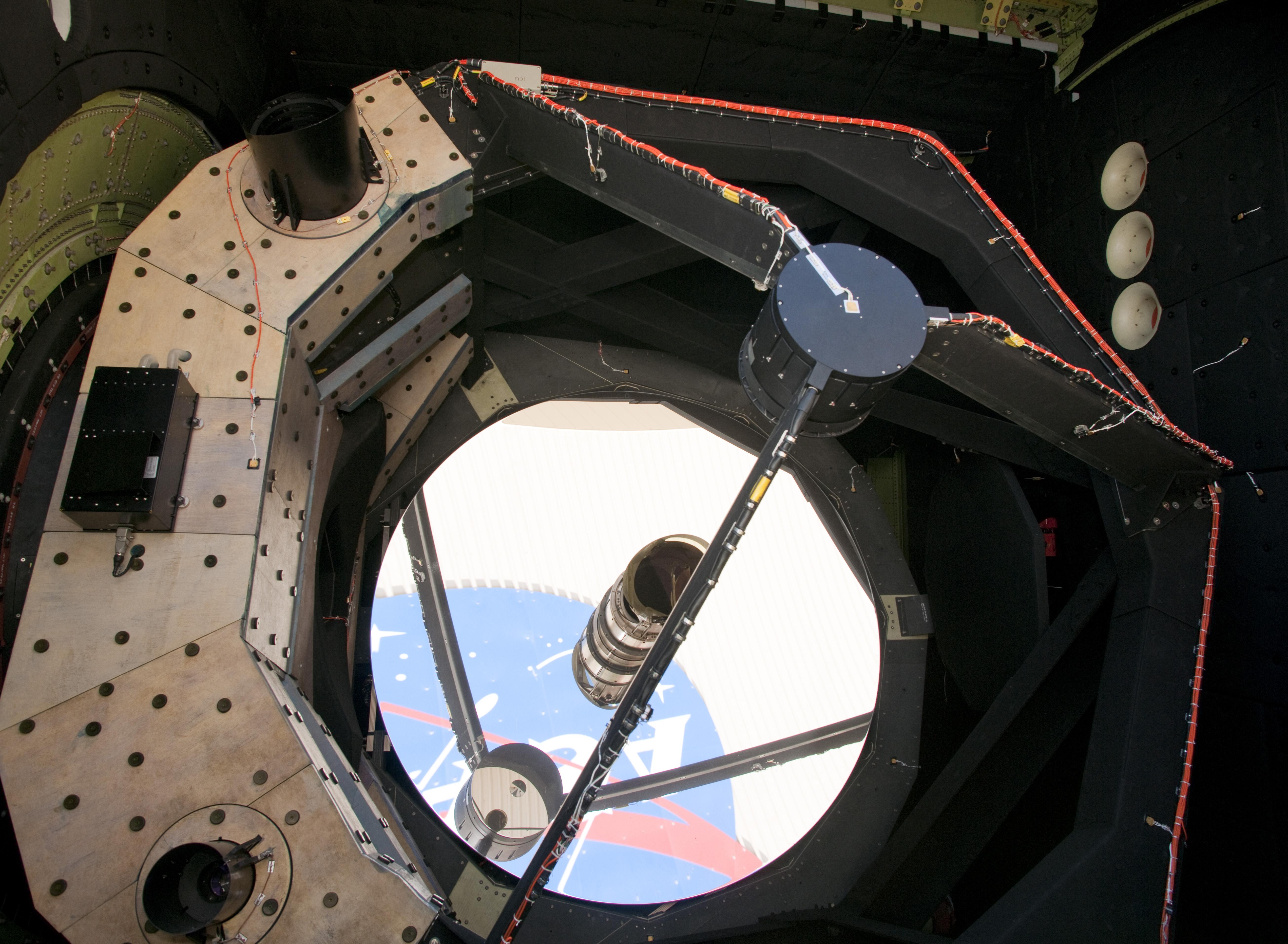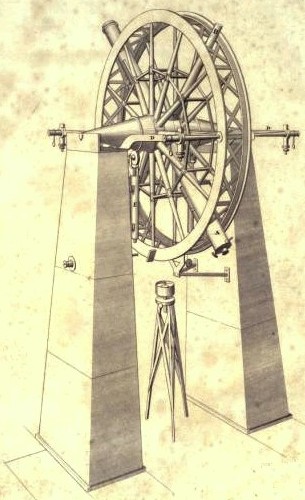|
Vertical Circle (instrument)
The vertical circle is an optical instrument used to measure angles in astronomy, which name is derived from the mathematical concept of the vertical circle from spherical geometry. It is a device for measuring astronomical angles, which can be rotated in altitude and azimuth. It consists of a telescope (in astronomical geodesy occasionally also with a reflecting telescope), which is mounted on a horizontal tilting axis and is supported by a stable altazimuth mount. It is similar in design to the meridian circle, but the latter only has a horizontal tilting axis without the means to change azimuth. The angular movements around the tilting and standing axes are measured with large, finely divided circles and a reading microscope.{{cite book , last=Chauvenet , first=William , author-link=William Chauvenet , date=1863 , title=A Manual of Spherical and Practical Astronomy , volume=II: Theory and use of astronomical instruments , url=https://books.google.com/books?id=AVI8pz41ia8C&pg=PA31 ... [...More Info...] [...Related Items...] OR: [Wikipedia] [Google] [Baidu] |
Optical Instrument
An optical instrument is a device that processes light waves (or photons), either to enhance an image for viewing or to analyze and determine their characteristic properties. Common examples include periscopes, microscopes, telescopes, and cameras. Image enhancement The first optical instruments were telescopes used for magnification of distant images, and microscopes used for magnifying very tiny images. Since the days of Galileo and Van Leeuwenhoek, these instruments have been greatly improved and extended into other portions of the electromagnetic spectrum. The binocular device is a generally compact instrument for both eyes designed for mobile use. A camera could be considered a type of optical instrument, with the pinhole camera and camera obscura being very simple examples of such devices. Analysis Another class of optical instrument is used to analyze the properties of light or optical materials. They include: * Interferometer for measuring the interference propertie ... [...More Info...] [...Related Items...] OR: [Wikipedia] [Google] [Baidu] |
Astronomy
Astronomy is a natural science that studies celestial objects and the phenomena that occur in the cosmos. It uses mathematics, physics, and chemistry in order to explain their origin and their overall evolution. Objects of interest include planets, natural satellite, moons, stars, nebulae, galaxy, galaxies, meteoroids, asteroids, and comets. Relevant phenomena include supernova explosions, gamma ray bursts, quasars, blazars, pulsars, and cosmic microwave background radiation. More generally, astronomy studies everything that originates beyond atmosphere of Earth, Earth's atmosphere. Cosmology is a branch of astronomy that studies the universe as a whole. Astronomy is one of the oldest natural sciences. The early civilizations in recorded history made methodical observations of the night sky. These include the Egyptian astronomy, Egyptians, Babylonian astronomy, Babylonians, Greek astronomy, Greeks, Indian astronomy, Indians, Chinese astronomy, Chinese, Maya civilization, M ... [...More Info...] [...Related Items...] OR: [Wikipedia] [Google] [Baidu] |
Vertical Circle
In spherical geometry, a vertical circle is a great circle on the celestial sphere that is perpendicular to the horizon. Therefore, it contains the vertical direction, passing through the zenith and the nadir. There is a vertical circle for any given azimuth, where azimuth is the angle measured east from the north on the celestial horizon. The vertical circle which is in the east–west direction is called the prime vertical. The vertical circle which is on the north–south direction is called the local celestial meridian (LCM), or principal vertical. Vertical circles are part of the horizontal coordinate system The horizontal coordinate system is a celestial coordinate system that uses the observer's local horizon as the fundamental plane to define two angles of a spherical coordinate system: altitude and ''azimuth''. Therefore, the horizontal coord .... See also * Vertical circle (instrument) References {{DEFAULTSORT:Vertical Circle Astronomical coordinate system ... [...More Info...] [...Related Items...] OR: [Wikipedia] [Google] [Baidu] |
Spherical Geometry
300px, A sphere with a spherical triangle on it. Spherical geometry or spherics () is the geometry of the two-dimensional surface of a sphere or the -dimensional surface of higher dimensional spheres. Long studied for its practical applications to astronomy, navigation, and geodesy, spherical geometry and the metrical tools of spherical trigonometry are in many respects analogous to Euclidean plane geometry and trigonometry, but also have some important differences. The sphere can be studied either ''extrinsically'' as a surface embedded in 3-dimensional Euclidean space (part of the study of solid geometry), or ''intrinsically'' using methods that only involve the surface itself without reference to any surrounding space. Principles In plane (Euclidean) geometry, the basic concepts are points and (straight) lines. In spherical geometry, the basic concepts are points and great circles. However, two great circles on a plane intersect in two antipodal points, unlike coplan ... [...More Info...] [...Related Items...] OR: [Wikipedia] [Google] [Baidu] |
Linda Hall Library
The Linda Hall Library is a privately endowed American library of science, engineering and technology located in Kansas City, Missouri, on the grounds of a urban arboretum. It claims to be the "largest independently funded public library of science, engineering and technology in North America" and "among the largest science libraries in the world." Description Established in 1946 through the philanthropy of Linda and Herbert F. Hall of the Hall-Bartlett Grain Co., the library is open to the public, and invites individual researchers, academic institutions, and companies from Kansas City and around the world to use the library's research-level collection. Its mission is to act as "guardian of the collective intellectual heritage with regard to the science, technology, and engineering disciplines." The library's William N. Deramus III Cosmology Theater, temporarily closed since 2020, shows images of the cosmos from the Hubble Space Telescope and NASA science missions. These imag ... [...More Info...] [...Related Items...] OR: [Wikipedia] [Google] [Baidu] |
Telescope
A telescope is a device used to observe distant objects by their emission, Absorption (electromagnetic radiation), absorption, or Reflection (physics), reflection of electromagnetic radiation. Originally, it was an optical instrument using lenses, curved mirrors, or a combination of both to observe distant objects – an optical telescope. Nowadays, the word "telescope" is defined as a wide range of instruments capable of detecting different regions of the electromagnetic spectrum, and in some cases other types of detectors. The first known practical telescopes were refracting telescopes with glass lenses and were invented in the Netherlands at the beginning of the 17th century. They were used for both terrestrial applications and astronomy. The reflecting telescope, which uses mirrors to collect and focus light, was invented within a few decades of the first refracting telescope. In the 20th century, many new types of telescopes were invented, including radio telescopes in t ... [...More Info...] [...Related Items...] OR: [Wikipedia] [Google] [Baidu] |
Astronomical Geodesy
Geodetic astronomy or astronomical geodesy (astro-geodesy) is the application of astronomical methods into geodetic networks and other technical projects of geodesy. Applications The most important applications are: * Establishment of geodetic datum systems (e.g. ED50) or at expeditions * apparent places of stars, and their proper motions * precise astronomical navigation * astro-geodetic geoid determination * modelling the rock densities of the topography and of geological layers in the subsurface * Monitoring of the Earth rotation and polar wandering * Contribution to the time system of physics and geosciences Measuring techniques Important measuring techniques are: * Latitude determination and longitude determination, by theodolites, tacheometers, astrolabes or zenith cameras * time and star positions by observation of star transits, e.g. by meridian circles (visual, photographic or CCD) * Azimuth determination ** for the exact orientation of geodetic network ... [...More Info...] [...Related Items...] OR: [Wikipedia] [Google] [Baidu] |
Reflecting Telescope
A reflecting telescope (also called a reflector) is a telescope that uses a single or a combination of curved mirrors that reflect light and form an image. The reflecting telescope was invented in the 17th century by Isaac Newton as an alternative to the refracting telescope which, at that time, was a design that suffered from severe chromatic aberration. Although reflecting telescopes produce other types of optical aberrations, it is a design that allows for very large diameter Objective (optics), objectives. Almost all of the major telescopes used in astronomy research are reflectors. Many variant forms are in use and some employ extra optical elements to improve image quality or place the image in a mechanically advantageous position. Since reflecting telescopes use mirrors, the design is sometimes referred to as a catoptrics, catoptric telescope. From the time of Newton to the 1800s, the mirror itself was made of metalusually speculum metal. This type included Newton's first ... [...More Info...] [...Related Items...] OR: [Wikipedia] [Google] [Baidu] |
Altazimuth Mount
An altazimuth mount or alt-azimuth mount is a simple two- axis mount for supporting and rotating an instrument about two perpendicular axes – one vertical and the other horizontal. Rotation about the vertical axis varies the azimuth (compass bearing) of the pointing direction of the instrument. Rotation about the horizontal axis varies the altitude angle (angle of elevation) of the pointing direction. These mounts are used, for example, with telescopes, cameras, radio antennas, heliostat mirrors, solar panels, and guns and similar weapons. Several names are given to this kind of mount, including altitude-azimuth, azimuth-elevation and various abbreviations thereof. A gun turret is essentially an alt-azimuth mount for a gun, and a standard camera tripod is an alt-azimuth mount as well. Astronomical telescope altazimuth mounts When used as an astronomical telescope mount, the biggest advantage of an alt-azimuth mount is the simplicity of its mechanical design. The primar ... [...More Info...] [...Related Items...] OR: [Wikipedia] [Google] [Baidu] |
Meridian Circle
The meridian circle is an instrument for timing of the passage of stars across the local meridian, an event known as a culmination, while at the same time measuring their angular distance from the nadir. These are special purpose telescopes mounted so as to allow pointing only in the meridian, the great circle through the north point of the horizon, the north celestial pole, the zenith, the south point of the horizon, the south celestial pole, and the nadir. Meridian telescopes rely on the rotation of the sky to bring objects into their field of view and are mounted on a fixed, horizontal, east–west axis. The similar transit instrument, transit circle, or transit telescope is likewise mounted on a horizontal axis, but the axis need not be fixed in the east–west direction. For instance, a surveyor's theodolite can function as a transit instrument if its telescope is capable of a full revolution about the horizontal axis. Meridian circles are often called by these names, alth ... [...More Info...] [...Related Items...] OR: [Wikipedia] [Google] [Baidu] |
Microscope
A microscope () is a laboratory equipment, laboratory instrument used to examine objects that are too small to be seen by the naked eye. Microscopy is the science of investigating small objects and structures using a microscope. Microscopic means being invisible to the eye unless aided by a microscope. There are many types of microscopes, and they may be grouped in different ways. One way is to describe the method an instrument uses to interact with a sample and produce images, either by sending a beam of light or electrons through a sample in its optical path, by detecting fluorescence, photon emissions from a sample, or by scanning across and a short distance from the surface of a sample using a probe. The most common microscope (and the first to be invented) is the optical microscope, which uses lenses to refract visible light that passed through a microtome, thinly sectioned sample to produce an observable image. Other major types of microscopes are the fluorescence micro ... [...More Info...] [...Related Items...] OR: [Wikipedia] [Google] [Baidu] |







